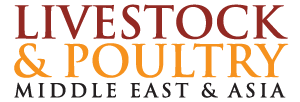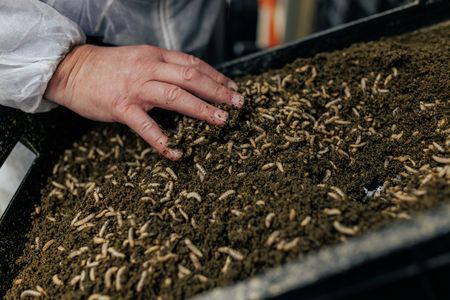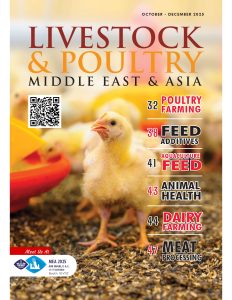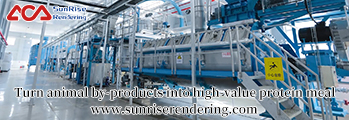Inhouse Farming – Feed & Food Show 2024 provides information on the agricultural and food systems – From 12 to 15 November in Hanover, Germany
Can the industrial breeding of insects as animal feed contribute to feeding the growing world population? The “Inhouse Farming – Feed & Food Show”, which will take place from 12 to 15 November 2024 at the trade fair grounds in Hanover, is dedicated to answering this question. The B2B platform organised by the DLG (German Agricultural Society) focuses on technologies and solutions that show that insects can now be used economically as an alternative source of protein for sustainable animal feed. “Inhouse Farming” optimally complements the world’s leading trade fair, EuroTier, and EnergyDecentral, the leading international platform for decentralised energy supply, which will take place at the same time, offering new perspectives and business models for the entire value chain.
For Prof Nils Borchard, Head of DLG Research and Development, insects are the missing link in the circular economy. “They could be the animal feed of the future, as they provide valuable proteins, fats and other nutrients. Their production is also very resource-efficient.” But what makes them the raw material for the feed production of the future? Answers to this question will be provided at the “Inhouse Farming – Feed & Food Show” in Hanover in mid-November.
Focus on the black soldier fly
Seven insect species are now authorised in the EU for use as processed animal protein in livestock feed. The larvae of the black soldier fly (Hermetia illucens) have proven to be ideal for the production of animal feed. Their protein content is comparable to that of soya bean meal – 40 to 47 per cent in dry matter. “The potential of larvae is huge,” confirms Dr Frank Hiller, CEO of Big Dutchman. This is because they produce high-quality protein from otherwise hardly usable residues, which is ideal as animal feed. Hiller assumes that the alternative protein source can permanently replace a significant proportion of the soya imported to Europe. For this reason, Big Dutchman has pooled its existing expertise in the field of insect farming and production in Better Insect Solutions, which was founded in 2020. The company, which specialises in complete solutions for insect farming, will be presenting its systems at the “Inhouse Farming – Feed & Food Show”.
What these look like in practice could be seen in Hvirring (Denmark) in November 2023 – when the Enorm Biofactory, currently the largest insect farm in Northern Europe, was opened. Larvae of the black soldier fly are bred on site on an area of 22,000 square metres and processed into insect protein and oil. Large parts of the technology, including the climate control systems for the breeding and fattening area, the exhaust air purification and heat recovery, the liquid feeding system and the boxes for fattening, were supplied by Better Insect Solutions. The experts plan and build complete high-tech insect farms for investors, including breeding, fattening and processing. The highly automated, modular fattening systems in the product range are aimed more at farmers who want to add another mainstay as insect fatteners.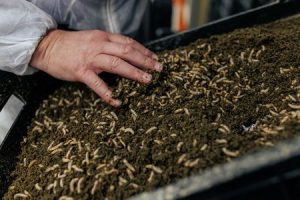
Opportunities for livestock feeding
The black soldier flies bred in the Enorm Biofactory are given food consisting mainly of waste from the regional food industry. After around twelve days, the larvae are processed into insect oil and meal, which have already shown promising results in trials on farms in terms of production and animal health in poultry and pigs. The aim is to produce 100 tonnes of larvae on a daily basis. Europe’s farmers want to avoid importing some of their soya from overseas in future by using insect-based protein feed. Even though beneficial insects have been authorised as an ingredient in fish feed since 2017, such animal feed has so far been a niche product in Europe. Only since September 2021 has it been possible to feed processed animal protein from farmed insects to pigs and poultry in the EU under a special regulation. This opens up new growth areas for producers of insect proteins such as Livin Farms AgriFood, Illucens and Viscon.
However, experts like Prof Nils Borchard see even more potential applications. In addition to being used as animal feed, the farmed insects or their constituents could also be used in the production of meat substitutes and other foods as well as in the manufacture of cosmetics. Until now, the production of insect protein has often been difficult from an economic point of view, as the production and processing methods are not yet able to compete with conventional animal feed. “Utilising agricultural by-products and by-products from the food industry as feed for insect breeding can help reduce production costs,” says Borchard. How the potential of organic residues and waste can be exploited is therefore one of the questions that will be discussed at the “Expert Stage: Inhouse Farming” on 12 November as part of the Insects theme day. The IPIFF (International Platform of Insects for Food and Feed), a non-profit EU organisation representing the interests of the insect production sector, is an expert partner in the development of the content.
Insects as upcycling professionals
The answer to this question has long since attracted the attention of research institutions and start-ups. There are more than enough residual materials, because “in the European Union, around 58 million tonnes of unused food are produced every year,” explains Prof. Jörg Woidasky from the Pforzheim University of Applied Sciences. The university has been cooperating with Alpha-Protein, a start-up from Bruchsal, Germany, for several years. “In addition to selecting suitable by-products from the food industry, we were also able to optimise the handling of the sensitive animals,” explains the expert in sustainable product development. Alpha-Protein uses these by-products as food for the mealworm (Tenebrio molitor) and upcycles them into a protein-rich raw material with vitamins, unsaturated fatty acids and minerals.
“In addition, we obtain a nutrient-rich plant fertiliser when rearing the mealworms, which has many other positive effects such as soil activation and long-term fertilisation. Last but not least, by utilising discarded insect skins (i.e. exuviae), we achieve full recycling of all our material flows,” says company founder Gia Tien Ngo. These are produced during the natural moulting process and are used to manufacture sustainable products such as alternative plastics. The researchers will now build on the results of the first project. The focus here is on the systems and automation of the rearing process. Industrial production is currently being planned in Ludwigshafen, Germany on an area of two hectares. The plan is to produce 1,000 tonnes of dried insects and over 5,000 tonnes of fertiliser annually. The plan is to feed used bread from bakeries in the region as a primary source of animal feed.
Challenges of automated breeding
The control of environmental factors such as temperature and humidity, the precise handling of sensitive fly eggs and the uniform portioning of freshly hatched larvae are complex tasks that need to be solved when automating breeding – a topic that the exhibiting companies at the “Inhouse Farming – Feed & Food Show” are also addressing. WEDA Dammann & Westerkamp, a specialist in feeding technologies, will also be present in Hanover. The company from Lutten recently supplied a corresponding system, including control and process visualisation, to the Portuguese company EntoGreen. The larvae of the black soldier fly are fed with the residues in the system of containers and mixing tanks until they reach their final weight. The integrated dosing system ensures a customised combination and precise portioning of the feed substrate in the fattening containers. The residues on which the larvae thrive consist of regional vegetable residues that can no longer be used for food production. “The system generates a substrate for a larval output of around 25 tonnes per day. Its modular structure makes it easy to scale for future expansion,” explains WEDA Export Manager Gabriel Schmidt. A new system is already being planned and is expected to produce up to 45 tonnes of live larvae from 2025 with a daily raw material input of 210 tonnes.
For additional information, go to:
Inhouse Farming – Feed & Food Show: www.inhouse-farming.com
EuroTier 2024: www.eurotier.com
EnergyDecentral: www.energy-decentral.com

